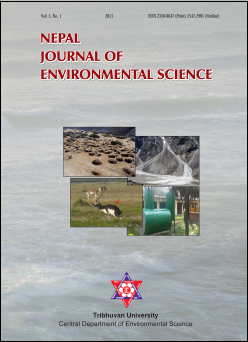Wildfire Dynamics in Nepal from 2000-2016
DOI:
https://doi.org/10.3126/njes.v5i0.22709Keywords:
Burnt area, wildfire densities, wildfires day, wildfire incidenceAbstract
Increasing trends of wildfire in recent year has become a serious concern across the world. However, in the Nepalese context, there seem limited studies carried out in connection to wildfires. Thus, the present research was objectively carried out to find out the trends, compare the wildfire incidence, burnt area, burning days and density of wildfire in the period before 2016 (2000-2015) and 2016. For the purpose, the Moderate Resolution Imaging Spector-Radiometer (MODIS) satellite images of Nepal were archived and literatures related to wildfires were collected from various sources. The burnt areas were calculated and wildfire incidences were counted in the image using ArcGIS. The wildfire events of before and during 2016 were compared by using excel program. The result showed wildfire incidence and burnt area are in increasing trends over the 17 years. The wildfire incidences were higher (around 33%) in 2016 in compared to the annual average incidences from 2000 to 2015. Similarly, there seems 42% more burnt areas in 2016 as compared to period from 2000 to 2015. Moreover, there seem 38 average annual wildfire days during the period from 2000-2015; however 40 wildfire days were recorded in 2016 adding two more days. The pre-monsoon period was found highly prone to wildfire incidence than the other seasons. The wildfire density showed around 0.09 incidence and 3.4 hectares burnt area per square km in 2016 which was only 0.03 incidences with 1.4 ha burnt area per km2 during 2000-2015. The highest density of wildfire was recorded to be nearly 0.16 incidences with 6.4 ha burnt area per km2 in 2016 in Tarai region. The findings will be helpful tool to wildfire ecology, wildfire managers and policy makers.
Downloads
Downloads
Published
How to Cite
Issue
Section
License
This license enables reusers to distribute, remix, adapt, and build upon the material in any medium or format for noncommercial purposes only, and only so long as attribution is given to the creator.

